On every sail, either things go wrong or they don’t. When they do go wrong, usually at least 2 or 3 things go wrong. Winter sailing is prime time for things going wrong because generally conditions are tougher. My Friday sail was one of those where a few things go wrong. Fortunately they were minor enough to be worth laughing over, and we had 3 days following where everything went right.
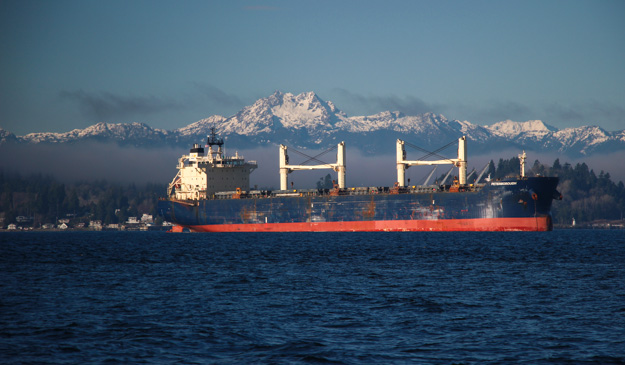

Friday: Shilshole -> Eagle Harbor
I had Monday off for MLK Day, so I took a vacation day Friday to make it a 4-day weekend. Natalie didn’t have Monday or Friday off though (she has less vacation accumulated than I do), so on Friday I singlehanded down to Eagle Harbor on Bainbridge. Eagle Harbor is our staging point when I want to sail somewhere and pick Natalie up – she can take the ferry over from downtown and I row over to the park to pick her up.
Friday had a small craft advisory with 20 knot winds from the south – against me of course. So I was a bit nervous heading out because that’s probably the most I’ve singlehanded in upwind. Downwind would be easy-peasy, but upwind is harder. It was wind against current, making for some choppy waves (wave spray hitting the dodger), and I had two close crossings – one with a tug in the shipping lanes who I was on a collision course with (he didn’t respond on VHF 16, but I bore off to take his stern).
Singlehanding
Singlehanding is always harder than sailing as a couple. But I like doing it to stretch myself. It requires thinking through all your moves in advance, and really knowing how your boat will respond in different conditions. It’s *way* more work though – at least 2x the work, because what 2 people would do is now handled by 1. But really it’s more than 2x work, because I do extra safety precautions – running jacklines, or reefing when we otherwise wouldn’t. It took close to 2 hours to prep the boat, and an hour to get it put back together once I reached Eagle Harbor. Even though it was only a 2 hour sail upwind, it was pretty exhausting.
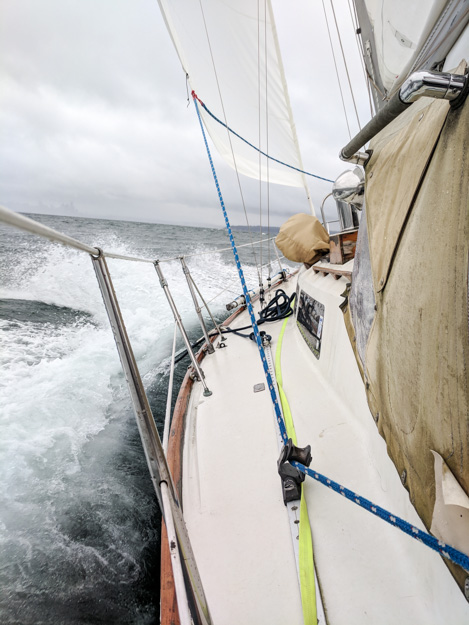
Bashing upwind in 20 knots (gusts to 22-23). Single reefed main, 135 genoa reefed to 100%.
Almost Losing the Dinghy
As I sailed into the Eagle Harbor entrance the waves were pretty choppy and confused. Our dinghy (“Matilda”) had been jerking on her line for a couple hours in the Sound, which must have stressed the dinghy painter (line). I heard a bang, and later noticed one of the dinghy painters was floating free in the water – broken. Fortunately the backup line had held. That line was on my list for replacement anyway. I’m glad it didn’t happen at a worse time though!
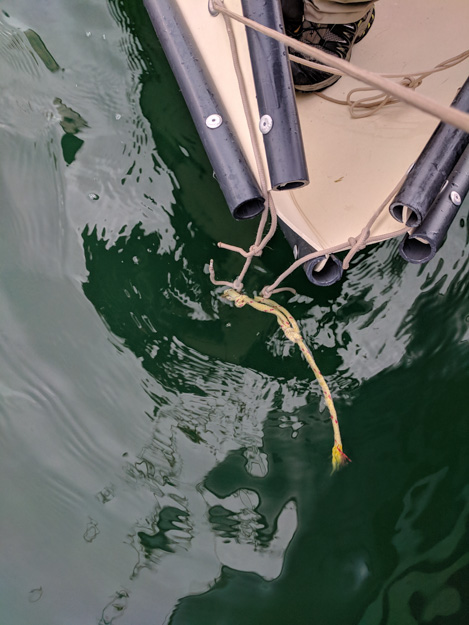
Losing the Water Tank (Contents)
After anchoring in Eagle Harbor, the boat quieted and I noticed it sounded like there was a lawnmower running – annoying, I thought. Odd though to be mowing your lawn in January. Approaching the companionway I realized it was our water pump. The galley faucet was open and our entire water tank had been flushed into the sea! The compost bin on the galley counter had slid into the faucet nozzle in some of the sloppy waves and opened it.
Surprisingly I hadn’t been able to hear the water pump over the noise of the wind (and later the engine, after sailing past the ferry dock). And it must have taken at least 10 or 20 minutes to flush our 29 gallon tank (I had filled the tank that morning).
This meant we had no water for the next 4 days though. Normally when cruising we carry a 5 gallon water can which would be our backup. But if this happened far from civilization we’d be in trouble. I’ll have to think through more precautions against losing our water tank (maybe no things on the counter, ever, while sailing). We turn off the water pressure whenever we leave the boat, but usually don’t while sailing because we’re regularly using it.
Fortunately Eagle Harbor is civilization so I worked out a plan to get water. I gathered all the water holding vessels I could think of and rowed to shore – the park bathroom had their water fountain turned off for the winter, but there were 2 ground water pumps to the left of the bathrooms. I got about 6-10 gallons that way.
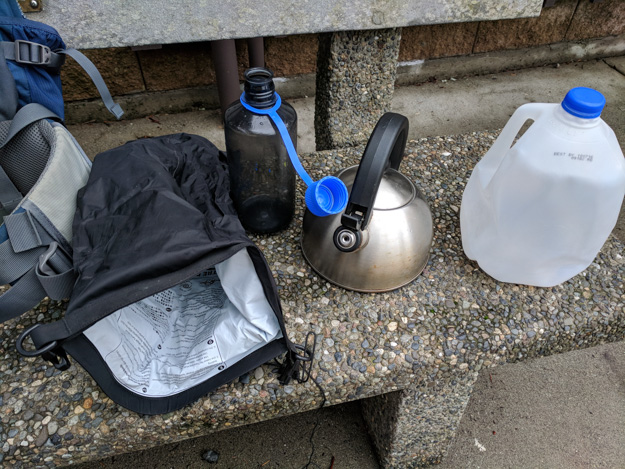
Water carrying containers. For later trips I ditched the kettle (inconvenient) and found the solar shower bag to be the best because it holds 10 L (~2.5 gallons).
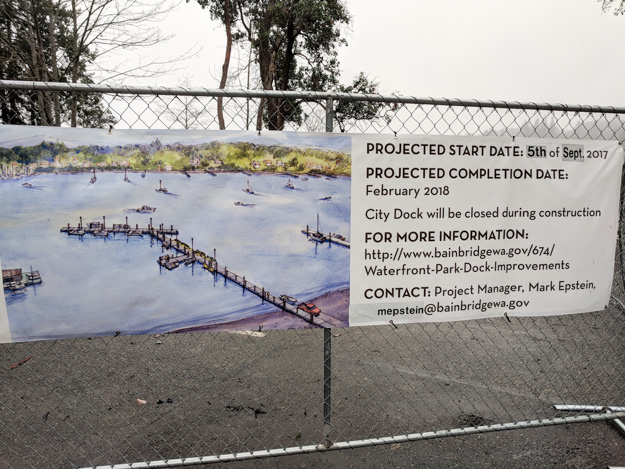
The new city dock in Eagle Harbor is coming along nicely – almost done. It’s much larger than I expected – a good deal more boats will be able to fit on it now.
Saturday: Eagle Harbor -> Blake Island
Saturday morning the wind disappeared so we motored the 5 miles to Blake Island around 1pm. We should’ve waited a couple hours because the wind came back, from the north, as the high pressure front moved in. But then we wouldn’t have gotten into the marina. It was almost full – we got the last inside spot in a C-dock. 5-6 more motor boats arrived after that, so if we had been later we’d be on a mooring ball. Which we don’t mind, but it’s nice to be in the marina for easy access to the awesome hiking there.
In the winter it should be easy to get into the Blake Island marina but in my experience it’s 100% full on most weekends. Powerboaters like it (the marina had 3 sailboats and 12-14 powerboats this weekend) because of the $6 power, which coupled with the annual moorage permit makes for a cheap marina stay with your electronics and heat on. There’s no shore power access where we were on the inside of a C dock, but we didn’t mind because we didn’t really need it.
The inside of the C-shaped docks does mean in a north wind, which sprung up around midnight, your boat is pushed against the dock, making for some squeaky bumpers that night.
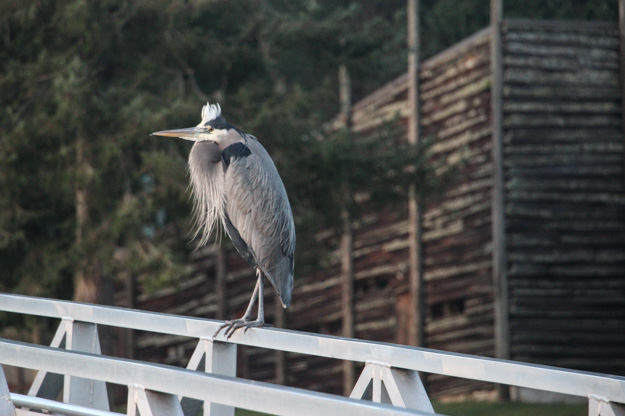
Woke up to a blue heron 15 feet away on the dock ramp.
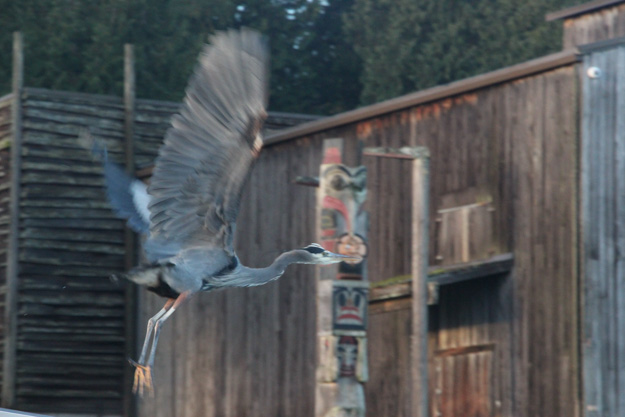
Diesel Pot Heater
I’ve written before about our diesel pot heater. In the winter while at anchor, a heat source is critical. But our diesel pot heater is pretty finicky. It takes 10 to 30 minutes to get lit, and it’s hard to dial in the fuel / air mixture well. Recently we finished off the kerosene and switched to #1 diesel in the heater tank. We had been using kerosene because we heard it’s cleaner burning.
The #1 diesel overall seems to be better – mainly because it’s easier to get dialed in to a stable flame level rather than periodically flaming up. Most likely our kerosene was overfueling the heater (even though I had adjusted the metering rate down). The diesel does burn less cleanly – more soot deposits are left behind, and the bottom of the pot has a glazed / carbonized look.
I’ve also been having a terribly hard time getting it lit – I inject stove alcohol and light that, but many times the alcohol extinguishes after 2-10 seconds. It’s infuriating because I can’t figure out why. I seem to have plenty of alcohol, because it will relight itself, but then immediately extinguish. Anyone who worries about diesel igniting obviously has never tried to light a diesel pot heater while cold.
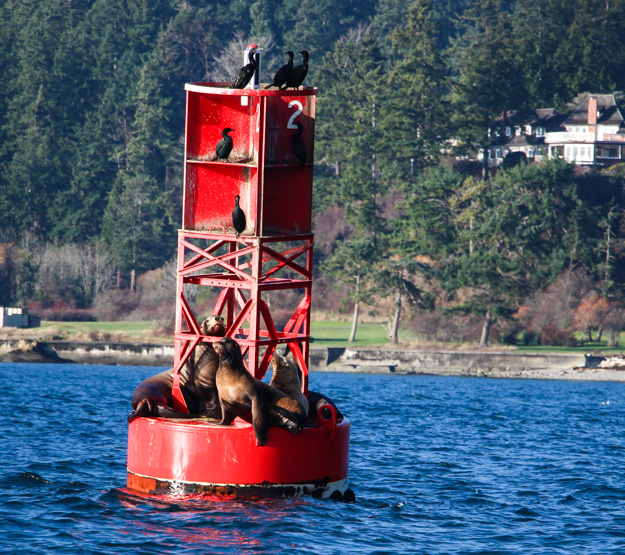
Seal party on the #2 buoy by Blakely Harbor. Birds are welcome too.
Sunday: Blake Island -> Eagle Harbor
Sunday we headed back to Eagle Harbor so Natalie could take the ferry to work Monday morning. Some north wind had been up all night, so we left about 11am and had a perfect sail in 8-10 knots of breeze. The sun came out, and the fog cleared. We took a dinghy ride around the inner marshlands of Eagle Harbor, and then docked it at the park dock (the temporary one) and headed to the Alehouse on Winslow. It was my first time there, and they had an impressive beer selection. Dogfish Head 120 Minute on tap, plus Founder’s Breakfast Stout and Hopworks Abominable on nitro!
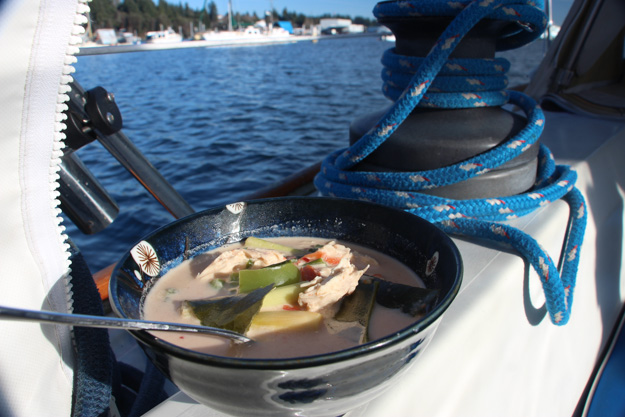
Tom ka gai for lunch
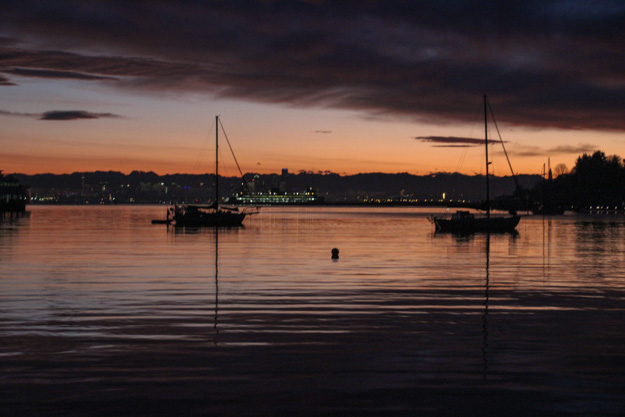
Sunrise on Monday from Eagle Harbor
Monday: Eagle Harbor -> Shilshole
Monday morning I brought Natalie ashore to catch the 7:05am ferry to her work. Later in the morning the West Point buoy showed 10 kts from the south, and then 12 kts, so I got excited and raised anchored, anticipating a nice downwind sail. As soon as I got out the wind dropped to 0. For an hour I played shifty, fluky winds – 3-4 kts from the west, then from the east, then NE, then NW. Then the wind dropped to 0 again so I took a break and made tom ka gai for lunch. Then I got 6-8 kts from the north, and ended up sailing within a mile of Shilshole before it died again and motoring the last mile.
4 hours 15 minutes to sail from Eagle Harbor to Shilshole is a rather long time, but it was a beautiful day for it. Apparently the temperature hit 64 F on Monday. T-shirt and shorts weather! It’s pretty rare to get spring in January. All in all it was a great extended weekend of cruising. I hope some of you got out there too.
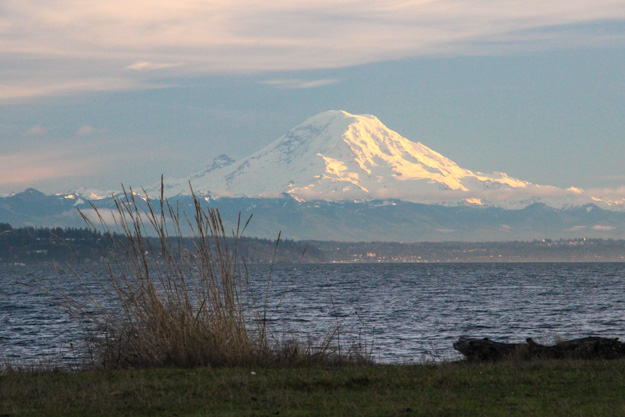

Installing a balanced draft for your Sigmar will really improve sooting and lighting problems. It killed me to drill a second big hole in our deck for the intake, but it made a huge difference!
Is your solar shower the thing that looked like an insulated dry bag? Because if it is I really want one! I’ve been patching my cheap ones which are really poorly engineered and a pain in the a$$…
I like your comments on single handing. I really need to put in some more miles just to remind my self of the need for thinking ahead.
Yup, it seals up like a dry bag. It’s the Sea to Summit pocket shower: http://amzn.to/2DqDkBB
Folds up really small when not in use. Doesn’t warm water very much, but that’s because we often don’t get much sun. 🙂
After the second time I emptied the water tanks while sailing, I now turn off the pressure water underway. I saw one person install a timer switch like you get in washrooms sometimes, that’d seemed like a nice idea.
Glad to know I’m not the only person this silly calamity has happened to. I’ve been thinking about the timer option – we rarely need to run the pump more than a minute, so a timer-based breaker would work. Not sure it’s worth the trouble though or whether there are good ones for easy 12V installation.
Commercial vessels are almost always on VHF CH 13. Try that next time you want to talk with one of them. CH 14 is a good one to monitor as all commercial traffic checks in with Seattle Traffic on that channel. I dual watch 13 and 14 on my radio….
If you’re dual watching 13 + 14, do you not monitor 16? Or do you mean on a scan setting or with two radios? I don’t like to use scan for long durations because it feels like it would use up the battery (of my handheld) more quickly.
I sail in the same general area a lot, and always listen to 16, 9, 13, and 14, plus using AIS. Rick is correct in that most of the tugs will answer on 13/
I work on towboats for a living and know that if I need to get in touch with a commercial vessel I’ll have a much better chance getting them on 13 with the first call. The thing is, they’re monitoring 13, the bridge to bridge channel, 14, the Seattle Traffic channel, plus whatever their company working channel is, so sometimes 16 gets lost in the shuffle.
On my sailboat, unless I’m in sight of other pleasure boats, I don’t really care whats going on on ch16. I’m much more worried about what commercial traffic is in the area and if i need to change my routing based on them. Going into Eagle Harbor for instance, I know that the ferry is going to hear my call to make passing arrangements for sure on 13.
Channel 14 is great to monitor as well. Every ferry checks in with Seattle Traffic upon departure from their dock. Traveling Rich Passage? It really nice to know when that ferry leaves Bremerton so you can time your meeting at the narrow spots there. You won’t get that info if you only monitor 16…..
Love your Blog. Hope to see you out there someday!
Interesting, didn’t know people talked to the ferries on 13. In Eagle Harbor they usually give me a 1 or 2 honk salute to indicate port or stbd passing. Rich Passage though is a bit of a blind corner and they come through there fast! (at least compared to a sailboat making 0 knots SOG because you’re trying to sail through in a club race and are a little early for the current change 🙂 ).
Great post! I sail over to Eagle Harbor and Blake Island more than anywhere else, mainly because I am based out of Elliott Bay Marina. I think in 2015 we went to Eagle Harbor 10+ times, and in 2017 Blake Island 9 times? They are great spots to visit, quick to get to for me, and have wonderful food, views, etc.
The other location we frequented in 2016-2017 a bunch is Bremerton Marina for a similar reason that you highlighted. I can single hand to Bremerton, provided you watch the tides, and then friends can take a 45 minute ferry ride over to hang out, or even to go sailing for half a day in the general area. The marina does not have anywhere near the ambiance as Winslow/Eagle Harbor, but it is another interesting spot to go if you want crew members to have ferry access.
I learned a nice trick for my diesel heater from a friend – a glob of Sterno gel works nicely to get the pot heated up and comes in a squirt bottle. The gel is pink so a little easier to see than clear and burns for several minutes.
Oh that’s a really nice idea! Sterno burns longer than alcohol so it won’t get easily extinguished by drafts, and it burns cleanly so no ash left behind (like with paper/tissue). I didn’t know they made it in squirt bottles. Found it: http://amzn.to/2DA50nO
Thanks!